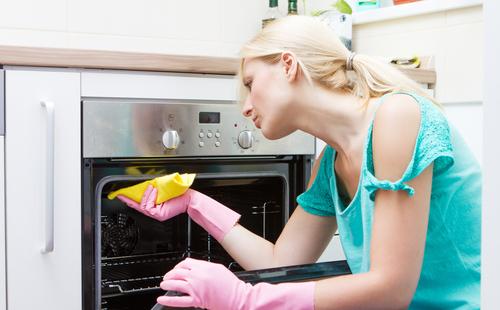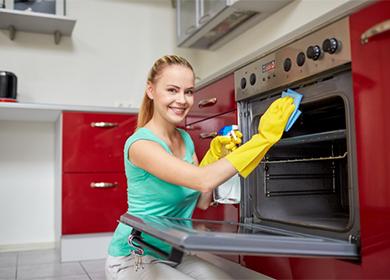The content of the article
Ideally, the oven should be washed after each use. But in practice this happens very rarely, and therefore the owner of dirty kitchen appliances have to rack their brains than wash the oven from old burnt fat.
The good news is that you can defeat old carbon deposits in any ovens, which are divided into gas and electric by type of heating. But the more modern the technology, the less effort you need to make.
Self-cleaning function: are trendy stoves so smart
If you bake often and set the table for a large family, then it is worth taking a closer look at appliances with a cleaning system. It can be catalytic, pyrolytic or hydrolytic. Which is more productive?
Catalytic
The main advantage of this function is that it works without human intervention, that is, automatically while the food is being prepared. Inside the oven has special catalytic plates. The porous coating of the fat-absorbing enamel contains a chemical composition that, when heated, triggers an oxidative reaction and prevents dirt from settling on the cabinet walls.
The principle of catalytic cleaning of the oven is used in both gas and electric ovens. The function greatly facilitates female labor: after cooking, the camera can only be wiped inside. Please note that for this abrasive materials that spoil the rough texture of the enamel will not work.

Hydrolysis
This technical solution was also created in the interests of women, but it cannot be called perfect. At its core, this is not self-cleaning, but just additional help in washing greasy stains, since a significant part of the work will have to be done manually.
The method of hydrolysis cleaning the oven is as follows: a little water is poured into a special depression on the bottom or in a baking sheet (for the effect, you can add a cleaning agent). The oven turns on, and under the influence of temperature, steam forms in it, which softens the impurities and helps to separate them from the walls of the chamber.
The main disadvantage of this method of cleaning is that you can use it until food residues and grease have dried in the oven.
Pyrolytic
It is considered the most effective way of self-cleaning electric ovens (in gas models, the function is not applicable). This is the heating of the oven to high numbers (up to 500 ° C), as a result of which the remains of food and fat are literally incinerated. After cooling, it is enough to wipe the walls of the oven and clean the glass of ash. This feature greatly facilitates the care of the oven. It is especially convenient if you often use the grill.
Among the shortcomings can be called the high price of such ovens and a significant consumption of electricity. In addition, the reviews of the owners of this miraculous technique indicate that with a rare cleaning of the oven during this procedure, an unpleasant burning smell may occur.
To avoid burns, do not forget that during pyrolysis the side walls of the oven become very hot. By the way, such a “neighborhood” is unlikely to appeal to adjacent furniture. Experts recommend maintaining a distance in such cases.

How to clean an oven at no cost
If you use a conventional oven without modern technological “bells and whistles”, you can clean the oven from carbon deposits in two ways:
- chemical means - which is fast, effective, but not always cheap and safe for health;
- folk remedies- which requires more time, but saves the family budget and is harmless.
Experienced housewives are advised to give preference to natural remedies and replace harmful chemistry with "grandmother" recipes. There are many products and nutritional supplements that are cheap, always at hand and able to quickly clean the electric oven inside. Here is a list of these indispensable helpers, as well as recommendations for their use.
Baking soda
We put on gloves.
- We breed soda in water. The amount of components is determined by eye: a non-liquid slurry should be obtained. Approximately a tablespoon of soda accounts for half a tablespoon of liquid.
- Apply to contaminated areas.
- After half an hour, wipe with a sponge.
- To cope with the old raid, you will have to additionally arm yourself with a “hedgehog”.
Table vinegar
- We put on gloves.
- Using a sponge, evenly apply ordinary vinegar to the inner surfaces, which is used by the housewives when cooking.
- After a couple of hours, wipe with a damp washcloth.

"Lemon"
- We put on gloves.
- We prepare acidified water: we dilute the juice of one lemon or a bag of citric acid in 0.5 l of warm water.
- Apply to the working walls for half an hour.
- Remove plaque with a tissue.
Ammonia
- We put on gloves.
- Open the window.
- We process the walls of the oven with ammonia using a sponge.
- In this form, leave "spend the night."
- Wash off with plenty of water in the morning.
Brown soap
- We put on gloves.
- Grind half a piece of laundry soap.
- Dissolve the chips in 250 ml of hot water.
- A container with a soapy composition is boiled in the oven for half an hour.
- Allow the surface to cool slightly, and then remove the softened, dirty slurry.
Steam
- We put on gloves.
- Pour water directly into the pan, you can add a little detergent.
- Turn on the oven at 180 ° C for 30-60 minutes.
- After cooling, remove fat deposits that exfoliate under the influence of steam.
Useful little things to simplify the procedure
The proposed folk remedies can be used to wash fat and burns both a gas oven and an electric stove. Please note that heating elements of an electric oven cannot be treated with products containing abrasive substances. The best combination for this purpose is a combination of ammonia and vinegar.
For the convenience of applying liquid solutions, you can use a spray gun, and old toothbrushes will help to apply creamy mixtures to remote places of the oven.

“Shumanit”, means with a brush and other “cleaners”
To combat burnt food and fat, household chemical manufacturers produce special cleaning products. Mostly they are designed for the most persistent pollution of the oven. Mistresses often resort to chemistry, preferring gels to clean the ovens:
- Frosch;
- "Mister Muscle";
- GreenClean;
- Faberlic
- Amvay.
Judging by the reviews, the latter tool from the list is very popular. It is also called a “tool with a brush,” because the container comes with a useful accessory.
How to use: 7 steps
The main stages of cleaning the oven with household chemicals are the same for all of the listed tools. Put on gloves, open windows. And then the procedure is carried out in seven steps.
- Remove all unnecessary from the oven: baking sheets, racks and shapes.
- Cover the fan (if available in this oven model).
- Apply gel or spray on all surfaces except heating parts.
- Leave the product for the time indicated in the instructions on the package.
- Wash the appliance thoroughly.
- You can boil water in a baking sheet with two to three tablets of activated carbon.
- If there is a smell of a chemical, treat the inner panels with lemon juice or vinegar water.
"General" door
Taking care of the cleanliness of the oven, do not forget to tidy its door. Theoretically, any of the above options will do. In practice, choosing what to clean the glass inside the oven, women prefer the following recipes.
- Just soda. Pour the substance onto the glass, sprinkle with water and leave for 30-40 minutes.
- Soda with soap. Pour a glass of warm water, liquid soap, and sprinkle half a teaspoon of soda into the spray bottle. Spray. The mixture is washed off after half an hour.
- Baking powder It must be scattered on the glass, sprinkled with water and wait an hour until the fat takes lumps. They are easy to remove with soapy water.
After weighing the pros and cons of the described methods, you will surely find a suitable option for yourself. But before you wash the oven from old fat inside, pay attention to the type of coating. Enameled surfaces, although resistant to mechanical stress, nevertheless require delicate care.Coarse-grained products should first be tested on an inconspicuous portion of the slab. To clean ovens from stainless steel, never use harsh sponges and aggressive cleaning agents, soda, acids or chlorides. Give preference to gel and cream preparations.

